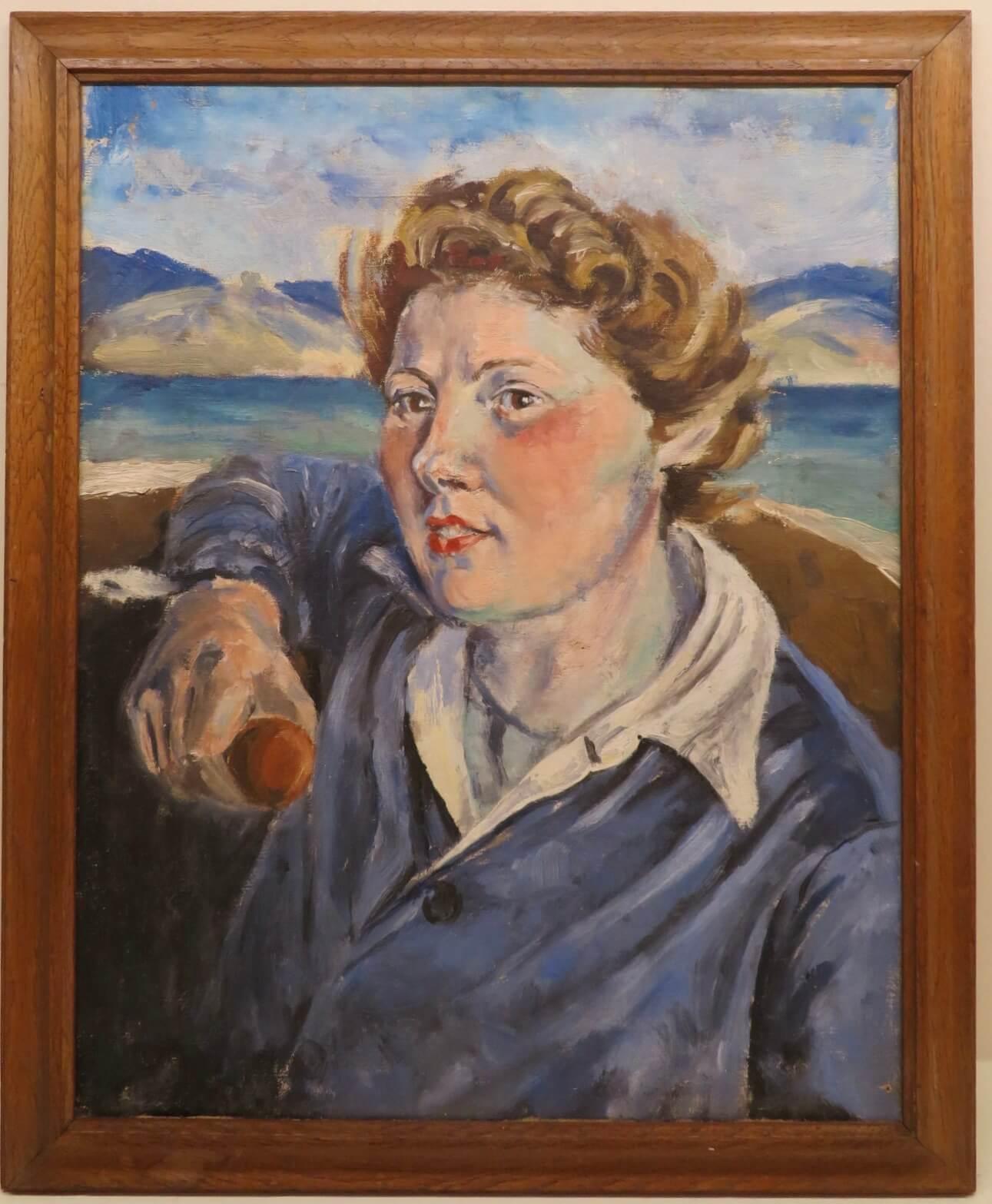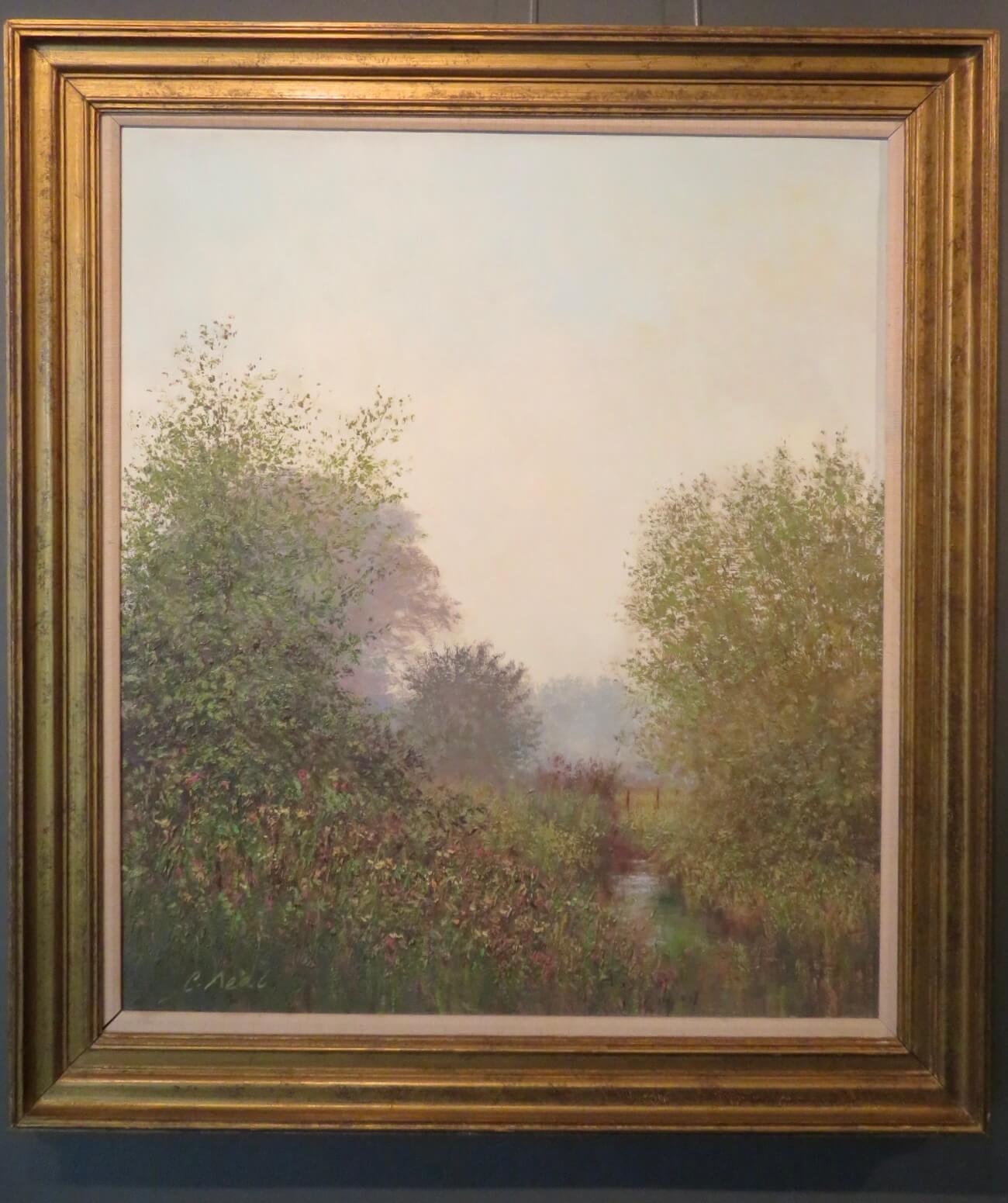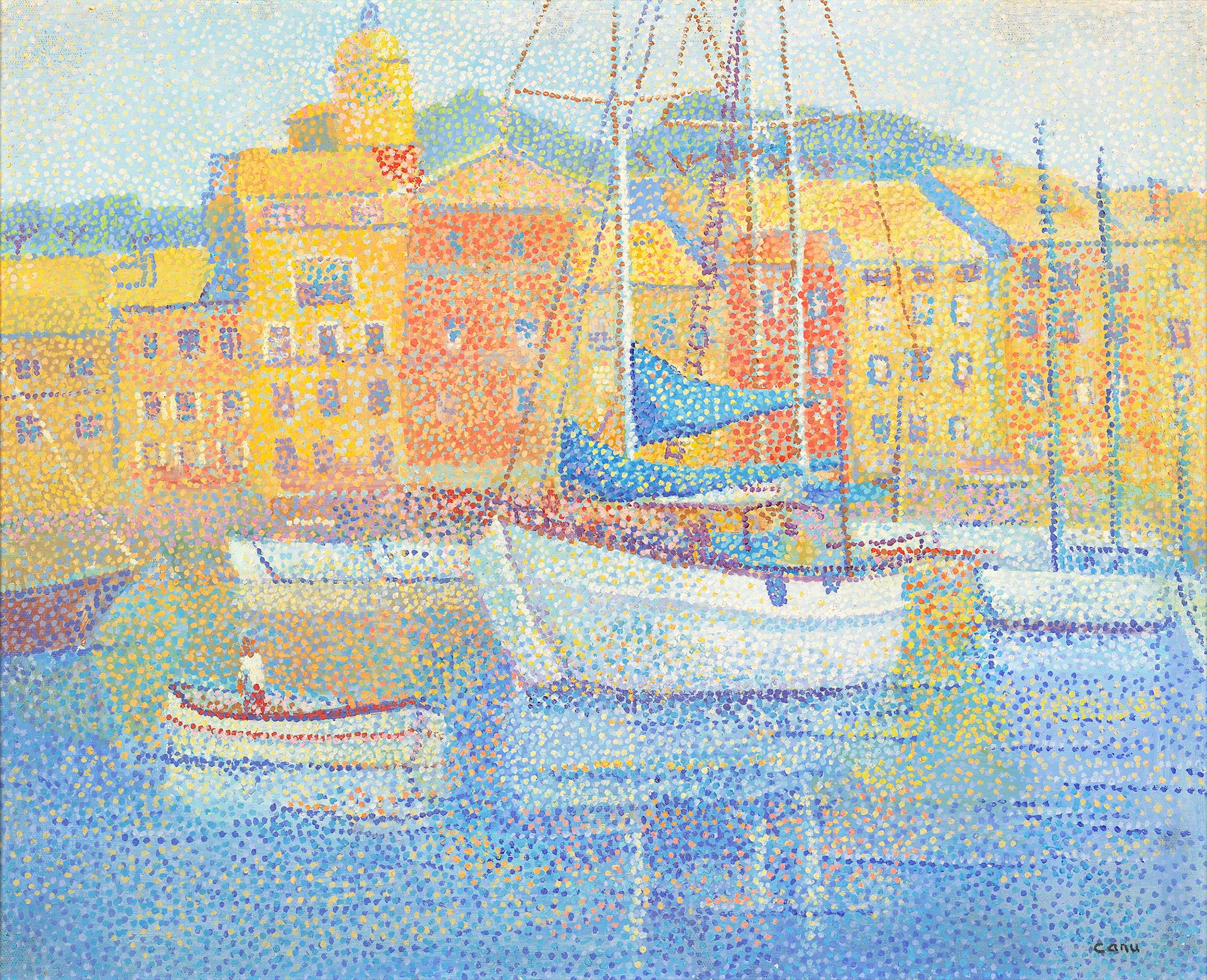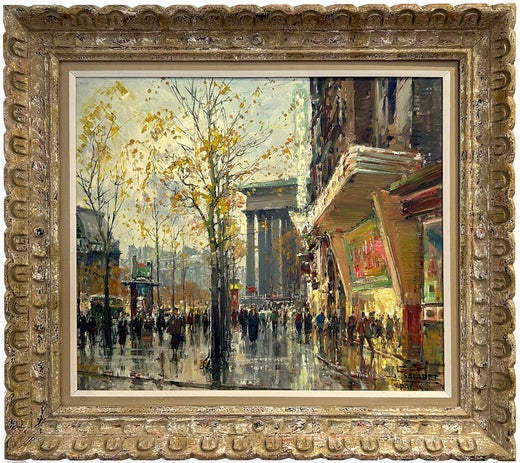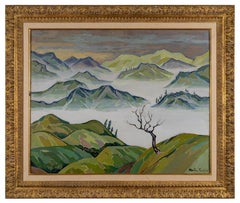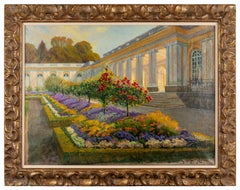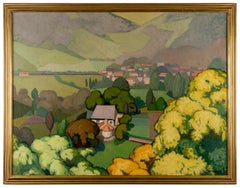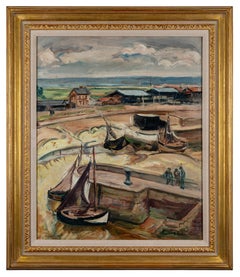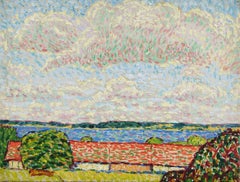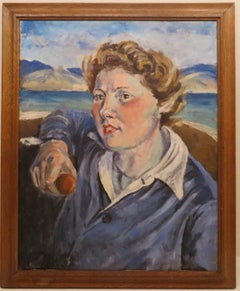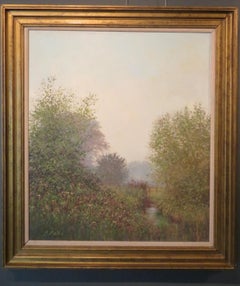Items Similar to Les Bouquinistes, Paris
Want more images or videos?
Request additional images or videos from the seller
1 of 8
Jean SalabetLes Bouquinistes, Paris1954
1954
About the Item
Jean Salabet
French, 20th Century
Les Bouquinistes, Paris
Oil on canvas
18 by 22 in. W/frame 24 by 28 in.
Signed lower left
Jean Salabet was a School of Paris painter know for his colorful Parisian cityscapes.
His work is comparable to those of Jules Herve, Antoine Blanchard and Edouard Cortes.
Provenance:
Private Collection New York
Le Trianon Fine Art & Antiques
Art S135
- Creator:Jean Salabet (French)
- Creation Year:1954
- Dimensions:Height: 24 in (60.96 cm)Width: 28 in (71.12 cm)Depth: 2 in (5.08 cm)
- Medium:
- Movement & Style:
- Period:
- Condition:
- Gallery Location:Sheffield, MA
- Reference Number:Seller: Art S1351stDibs: LU70036066522
Jean Salabet
Jean Salabet was a School of Paris painter known for his colorful Parisian cityscapes. His work is comparable to those of Jules Herve, Antoine Blanchard and Edouard Cortes.
About the Seller
4.0
Vetted Professional Seller
Every seller passes strict standards for authenticity and reliability
1stDibs seller since 2017
52 sales on 1stDibs
Typical response time: 17 hours
- ShippingRetrieving quote...Shipping from: Sheffield, MA
- Return Policy
Authenticity Guarantee
In the unlikely event there’s an issue with an item’s authenticity, contact us within 1 year for a full refund. DetailsMoney-Back Guarantee
If your item is not as described, is damaged in transit, or does not arrive, contact us within 7 days for a full refund. Details24-Hour Cancellation
You have a 24-hour grace period in which to reconsider your purchase, with no questions asked.Vetted Professional Sellers
Our world-class sellers must adhere to strict standards for service and quality, maintaining the integrity of our listings.Price-Match Guarantee
If you find that a seller listed the same item for a lower price elsewhere, we’ll match it.Trusted Global Delivery
Our best-in-class carrier network provides specialized shipping options worldwide, including custom delivery.More From This Seller
View AllMountainous Landscape
By Jacques Martin-Ferrières
Located in Sheffield, MA
Jacques Martin-Ferrieres
French, 1893 – 1972
Mountainous Landscape
Oil on canvas
25 ½ by 32 in, w/ frame 34 by 40 ¼ in
Signed lower right “Martin Ferrieres”
A painter remarkable ...
Category
Early 20th Century Post-Impressionist Landscape Paintings
Materials
Oil
Les Jardin du Versailles
Located in Sheffield, MA
George Roux
French, 1853-1929
Les Jardin du Versailles
Oil on canvas
23 ⅝ by 32 in, w/ frame 30 ¼ by 38 ½ in
Signed lower right
George Roux was a French ...
Category
Late 19th Century Post-Impressionist Landscape Paintings
Materials
Oil
Fauvist Landscape
Located in Sheffield, MA
George-Henri Tribout
French, 1884-1962
Fauvist Landscape
Oil on board
31 ½ by 41 ¾, w/ frame 34 ½ by 44 ½ in
Signed lower right
George Henri Tribout was born in Paris in 1884. He s...
Category
Early 20th Century Fauvist Landscape Paintings
Materials
Oil
Vieux Bassin de Honfleur
By Achille-Émile Othon Friesz
Located in Sheffield, MA
Achille-Emile Othon Friesz
French, 1879-1949
Vieux Bassin de Honfleur
Oil on canvas
23 ½ by 28 ¾ in, w/ frame 31 ⅜ by 36 ½ in
Signed lower right
Achille-Emile Othon Friesz, who lat...
Category
Early 20th Century Fauvist Landscape Paintings
Materials
Oil
Woman and Child
By John Edward Costigan
Located in Sheffield, MA
John Edward Costigan, N.A.
American, 1888-1972
Woman and Child
Oil on canvas
Signed ‘J.E. Costigan N.A.’ lower left
24 by 30 in. W/frame 32 by 38 in.
John Costigan was born of Irish-American parents in Providence, Rhode Island, February 29, 1888. He was a cousin of the noted American showman, George M. Cohan, whose parents brought the young Costigan to New York City and was instrumental in starting him on a career in the visual arts. They were less successful in encouraging him to pursue formal studies at the Art Students League (where, however, he later taught) than in exposing him to the commercial art world through the job they had gotten him with the New York lithographing firm that made their theatrical posters.
At the H. C. Miner Lithographing Company, Costigan worked his way up from his entry job as a pressroom helper, through various apprenticeships, to the position of sketch artist. In the latter capacity he was an uncredited designer of posters for the Ziegfeld Follies and for numerous silent films. Meanwhile, he had supplemented his very meager formal studies in the fine arts with a self-teaching discipline that led to his first professional recognition in 1920 with the receipt of prizes for an oil painting and watercolor in separate New York exhibitions.
A year earlier, Costigan had wed professional model Ida Blessin, with whom he established residence and began raising a family in the sleepy little rural New York hamlet of Orangeburg, the setting for the many idyllic farm landscapes and wood interiors with which he was to become identified in a career that would span half a century.
John Costigan’s first national recognition came in 1922 with his winning of the coveted Peterson Purchase prize of the Art Institute of Chicago for an oil on canvas, “Sheep at the Brook.” It marked the start of an unbroken winning streak that would gain him at least one important prize per year for the remainder of the decade. The nation’s art journalists and critics began to take notice, making him the recurring subject of newspaper features and magazine articles. The eminent author and critic Edgar Holger Cahill was just a fledgling reporter when he wrote his first feature, “John Costigan Carries the Flame,” for Shadowland Magazine in 1922. Costigan had his first one-man show of paintings at the Rehn Gallery on New York’s 5th Avenue in November, 1924, to be followed less than three years later by another at the Art Institute of Chicago. In addition, Costigan’s work has been—and continues to be included, side-by-side with that of some of America’s most high-profile artists, in museum and gallery exhibitions throughout the country. His renown had peaked in the early 1930s, by which time his work had been honored with nearly every major award then being bestowed in the fine arts and had been acquired for the permanent collections of several prestigious American museums, including New York’s Metropolitan (which only recently, in 1997, deaccessioned his “Wood Interior,” acquired in 1934).
Although Costigan’s celebrity had ebbed by the late 1930s, the Smithsonian Institution saw fit in 1937 to host an exhibition exclusively of his etchings. And, in 1941, the Corcoran Gallery (also Washington, D.C.) similarly honored him for his watercolors. (Another Washington institution, the Library of Congress, today includes 22 Costigan etchings and lithographs in its permanent print collection.)
During World War II, Costigan returned briefly to illustrating, mainly for Bluebook, a men’s pulp adventure magazine. A gradual revival of interest in his more serious work began at the end of the war, culminating in 1968 with the mounting of a 50-year Costigan retrospective at the Paine Art Center and Arboretum in Oshkosh, Wisconsin. Oils, watercolors and prints were borrowed from museums and private collections throughout the country, and the exhibition was subsequently toured nationally by the Smithsonian Institution.
John Costigan died of pneumonia in Nyack, NY, August 5, 1972, just months after receiving his final prestigious award —the Benjamin West Clinedinst Medal of the Artist’s Fellowship, Inc., presented in general recognition of his “...achievement of exceptional artistic merit...” in the various media he had mastered in the course of his career.
This painting depicts one of the artist's favorite themes --the farm family bathing...
Category
1940s Post-Impressionist Landscape Paintings
Materials
Oil
Bathers
By John Edward Costigan
Located in Sheffield, MA
John Edward Costigan, N.A.
American, 1888-1972
Bathers
Oil on canvas
Signed ‘J.E. Costigan N.A.’ lower left
20 by 24 in. W/frame 26 by 30 in.
John Costigan was born of Irish-American parents in Providence, Rhode Island, February 29, 1888. He was a cousin of the noted American showman, George M. Cohan, whose parents brought the young Costigan to New York City and was instrumental in starting him on a career in the visual arts. They were less successful in encouraging him to pursue formal studies at the Art Students League (where, however, he later taught) than in exposing him to the commercial art world through the job they had gotten him with the New York lithographing firm that made their theatrical posters.
At the H. C. Miner Lithographing Company, Costigan worked his way up from his entry job as a pressroom helper, through various apprenticeships, to the position of sketch artist. In the latter capacity he was an uncredited designer of posters for the Ziegfeld Follies and for numerous silent films. Meanwhile, he had supplemented his very meager formal studies in the fine arts with a self-teaching discipline that led to his first professional recognition in 1920 with the receipt of prizes for an oil painting and watercolor in separate New York exhibitions.
A year earlier, Costigan had wed professional model Ida Blessin, with whom he established residence and began raising a family in the sleepy little rural New York hamlet of Orangeburg, the setting for the many idyllic farm landscapes and wood interiors with which he was to become identified in a career that would span half a century.
John Costigan’s first national recognition came in 1922 with his winning of the coveted Peterson Purchase prize of the Art Institute of Chicago for an oil on canvas, “Sheep at the Brook.” It marked the start of an unbroken winning streak that would gain him at least one important prize per year for the remainder of the decade. The nation’s art journalists and critics began to take notice, making him the recurring subject of newspaper features and magazine articles. The eminent author and critic Edgar Holger Cahill was just a fledgling reporter when he wrote his first feature, “John Costigan Carries the Flame,” for Shadowland Magazine in 1922. Costigan had his first one-man show of paintings at the Rehn Gallery on New York’s 5th Avenue in November, 1924, to be followed less than three years later by another at the Art Institute of Chicago. In addition, Costigan’s work has been—and continues to be included, side-by-side with that of some of America’s most high-profile artists, in museum and gallery exhibitions throughout the country. His renown had peaked in the early 1930s, by which time his work had been honored with nearly every major award then being bestowed in the fine arts and had been acquired for the permanent collections of several prestigious American museums, including New York’s Metropolitan (which only recently, in 1997, deaccessioned his “Wood Interior,” acquired in 1934).
Although Costigan’s celebrity had ebbed by the late 1930s, the Smithsonian Institution saw fit in 1937 to host an exhibition exclusively of his etchings. And, in 1941, the Corcoran Gallery (also Washington, D.C.) similarly honored him for his watercolors. (Another Washington institution, the Library of Congress, today includes 22 Costigan etchings and lithographs in its permanent print collection.)
During World War II, Costigan returned briefly to illustrating, mainly for Bluebook, a men’s pulp adventure magazine. A gradual revival of interest in his more serious work began at the end of the war, culminating in 1968 with the mounting of a 50-year Costigan retrospective at the Paine Art Center and Arboretum in Oshkosh, Wisconsin. Oils, watercolors and prints were borrowed from museums and private collections throughout the country, and the exhibition was subsequently toured nationally by the Smithsonian Institution.
John Costigan died of pneumonia in Nyack, NY, August 5, 1972, just months after receiving his final prestigious award —the Benjamin West Clinedinst Medal of the Artist’s Fellowship, Inc., presented in general recognition of his “...achievement of exceptional artistic merit...” in the various media he had mastered in the course of his career.
This painting depicts one of the artist's favorite themes --the farm family bathing...
Category
1950s Post-Impressionist Figurative Paintings
Materials
Oil
You May Also Like
Carlos Nadal, Pont de Ville
By Carlos Nadal
Located in Madrid, ES
CARLOS NADAL
Spanish, 1917 - 1998
PONT DE VILLE
signed "Nadal" (lower right)
titled, signed and dated "PONT DE VILLE / Nadal / 1981" (on the reverse)
with the atelier stamp (on the r...
Category
1980s Fauvist Landscape Paintings
Materials
Oil, Canvas
Hans Michaelson Oil Paint on Canvas "Seelandschaft mit hohem Himmel", 1909-1912
By Hans Michaelson
Located in Berlin, DE
Oil paint on canvas, 1909/1912 by Hans Michaelson, Germany. Estate stamp verso. Framed.
Dimensions: 16.65 x 21.77 in ( 42,3 x 55,3 cm )
Hans Michaelson born as the son of Jewish traders in Hettstedt in 1872. From 1898 to 1909 he studied at the Berlin Academy. From 1912 on he regularly participated in the "juried outdoor art exhibition" Berlin and also the exhibition of the Berlin Secession...
Category
Early 20th Century Pointillist Landscape Paintings
Materials
Oil, Canvas
Margaret Nicholson - A Mid 20th Century Scottish Oil Painting PORTRAIT OF A LADY
Located in Cirencester, GB
ARTIST: Margaret Dorothy Nicholson (1886-1972) British
TITLE: "Portrait Of A Lady Steering A Boat"
SIGNED: unsigned
MEDIUM: oil on board
SIZE: 57cm x 47cm inc frame
CONDITION: ver...
Category
Mid-20th Century Post-Impressionist Portrait Paintings
Materials
Oil
Original BIG post impressionist oil painting COTSWOLD LANDSCAPE by Charles Neal
By Charles Neal
Located in Cirencester, GB
ARTIST: Charles Neal (1951-) British
TITLE: “Cotswolds Misty River Scene”
SIGNED: lower left with provenance from the Omell Galleries London
MEDIUM: oil o...
Category
Late 20th Century Post-Impressionist Landscape Paintings
Materials
Oil
Saint-Tropez, Le Port By Yvonne Canu
By Yvonne Canu
Located in New Orleans, LA
Yvonne Canu
1921-2008 French
Saint-Tropez, le port
Signed "CANU" (lower right)
Oil on canvas
The peaceful port of Saint-Tropez is captured in serene detail in this extraordinary...
Category
20th Century Post-Impressionist Landscape Paintings
Materials
Canvas, Oil
Cadaques Spain oil painting seascape mediterranean art
By Rafael Duran Benet
Located in Barcelona, Barcelona
Title: Cadaqués from the Olive Grove
Artist: Rafael Duran Benet (Terrassa, 1931 – Barcelona, 2015)
Technique: Oil on canvas board
Dimensions: 16,14 x 12,99 in
Support: Canvas board
S...
Category
1970s Post-Impressionist Landscape Paintings
Materials
Canvas, Oil, Cardboard
Recently Viewed
View AllMore Ways To Browse
Ross Penhall
Ruth Armer On Sale
Ruth Leialoha Kanahele Iversen
Sabate De Mora
Samuel Lancaster Gerry
Sannier Daniel
Sarah Lapierre Paintings
Schuyler Standish On Sale
Scope Of Vittorio
Senja Brendon
Severin Nilsson
Sevilla Saez
Slavsko Kvitne
Spencer Simmons
Stephane Wrobel
Stephen Coyle
Steve Sangapore
Svan Grandin

